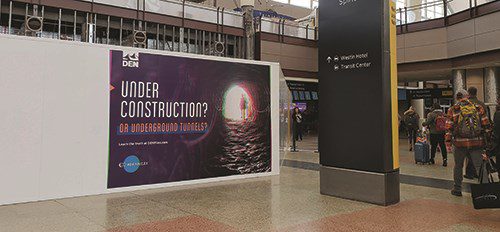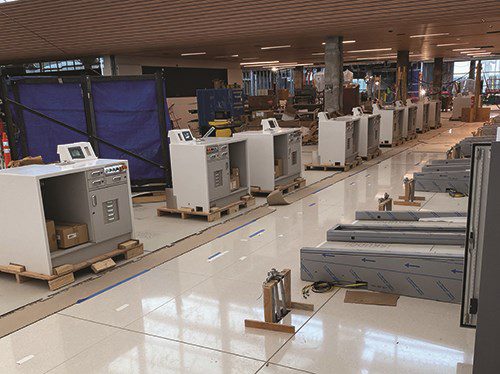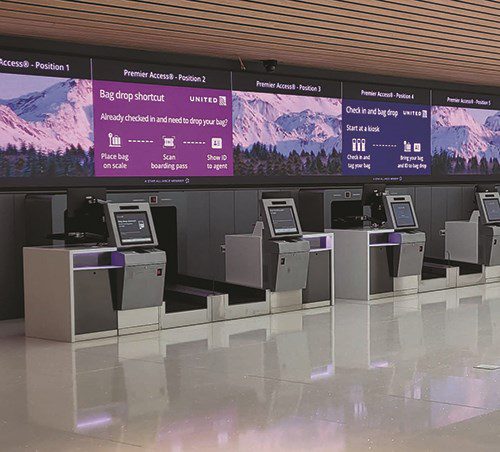It may be hard to believe, but it has already been 26 years since Denver International Airport (DEN) sprang up east of downtown Denver to replace Stapleton International, which was located in the midst of the growing city.
It may be hard to believe, but it has already been 26 years since Denver International Airport (DEN) sprang up east of downtown Denver to replace Stapleton International, which was located in the midst of the growing city. Over the years, the “new” airport’s tented roofs have become iconic, and times have changed. The entire industry has evolved, and DEN’s passenger numbers have grown dramatically. To address those changes and prepare for projected future growth, the airport is in the midst of making $770 million worth of upgrades to the Jeppesen Terminal.
 The multi-phase, still-evolving program known as The Great Hall Project is designed to improve the passenger security screening process and provide a more flexible and open airline check-in space with new ticketing and self-drop baggage kiosks. New restrooms and facility updates are other key components. When crews finished the first phase of the comprehensive project this past November, DEN became a U.S. leader in the self-serve bag drop movement.
The multi-phase, still-evolving program known as The Great Hall Project is designed to improve the passenger security screening process and provide a more flexible and open airline check-in space with new ticketing and self-drop baggage kiosks. New restrooms and facility updates are other key components. When crews finished the first phase of the comprehensive project this past November, DEN became a U.S. leader in the self-serve bag drop movement.
It’s all part of Vision 100, a comprehensive plan designed to allow the airport to serve 100 million annual passengers, a milestone officials expect to hit some time between 2030 and 2035. Michael Sheehan, senior vice president of Special Projects at DEN, explains that the plan has four pillars—empowering people, growing infrastructure, maintaining existing facilities and expanding global connections. The plan’s four guiding principles are sustainability, equity/diversity/inclusion, stakeholder involvement and the customer experience. “The vision that our new CEO [Phillip Washington] has identified is a terminal that accommodates 100 million annual passengers,” Sheehan summarizes.
|
facts&figures Project: Terminal Expansion/Renovation Location: Denver Int’l Airport Focus Area: Great Hall/Jeppesen Terminal Phase 1: New layout & ticketing/bag drop kiosks at check-in; new restrooms & other facility/infrastructure upgrades Construction: Completed in Nov. 2021
Phase 2: Relocating & enhancing Construction: Began in July 2021, slated to end by mid-2024 Anticipated Cost: $770 million (Phases 1 & 2) Guiding Objectives: Improving passenger throughput & service; updating facilities/systems to eventually serve 100 million annual travelers Designer: Stantec Construction Manager/General Contractor: Hensel Phelps Self-Serve Baggage Drop System: Materna IPS Displays: Daktronics Content Software: SITA Escalators & Elevators: ThyssenKrupp
Mechanical HVAC & Plumbing: Trautman Modular Walls: SwiftWall
Proposed Completion Phase: $1.3 billion, |
When DEN originally opened, it was handling 25 million passengers per year. Originally designed to accommodate 50 million annual passengers, Jeppesen Terminal was beyond capacity with 69 million prior to the pandemic. The facility was also showing its age, with cracks in the floors and outdated systems beginning to fail. By end of 2022, officials expect passenger volume be around 72 million.
 “Vision 100 goes across our entire airport,” says DEN Communications Director Mindy Crane. “We’re the economic engine for the region, and we have to keep investing in the airport to keep that economic engine running and continuing to increase its impact throughout the community.”
“Vision 100 goes across our entire airport,” says DEN Communications Director Mindy Crane. “We’re the economic engine for the region, and we have to keep investing in the airport to keep that economic engine running and continuing to increase its impact throughout the community.”
Security Drives Changes
Jeppesen Terminal, like many facilities constructed during or before the 1990s, was not equipped to accommodate the security changes prompted by the 9/11 terrorist attacks. “What used to be this great, wide-open terminal for socializing and folks to enjoy concessions, became a sea of security at our north and south ends,” explains Sheehan. The need to change layouts for post-9/11operations became a driving force for the Great Hall Project. While doing so, the airport is also preparing for future changes, increasing capacity and updating technology—all to provide a better passenger experience, notes Sheehan.
Phase 1 of the Great Hall Project, which kicked off in the first quarter of 2020, adds new ticketing areas in the center of Level 6 for DEN’s two dominant carriers, United Airlines and Southwest Airlines, as well as space for Frontier Airlines. In addition to updating 158,500 square feet of the existing footprint, Phase 1 added 31,000 square feet to the Jeppesen Terminal on levels 5 and 6.
As project designer, Stantec upgraded and refreshed the terminal’s finishes while enhancing checkpoint flow and operational efficiencies. Phase 1 improvements include four new restrooms, new large-tile flooring and other aesthetic updates. “It’s bright and light, with new finishes,” says Sheehan. Crews also made changes that will go unnoticed by most passengers. The existing HVAC system and lighting control system were both improved.
The airport relocated its two largest carriers, United Airlines and Southwest Airlines, into the newly improved space in early November. Phase 2 work, which began in July 2021 and is expected to end by mid-2024, includes construction of a new security checkpoint in the northwest corner of the terminal. The new checkpoint on Level 6 will allow DEN to convert space on Level 5 that was previously used for security into space for new passenger amenities.
In mid-December, airport officials asked the Denver City Council to approve a final phase worth $1.3 billion. If approved, that would bring the total anticipated cost of all three phases to $2.1 billion. The proposed Completion Phase is programmed to be finished in 2028 and include a new security checkpoint on the northeast side of Level 6, new check-in areas on the south end of Level 6 and more general facility renovations. Plans also include the creation of the Center of Excellence and Equity in Aviation, which would be located on Level 4 of the DEN Westin Hotel and Transit Center—a space that is currently vacant.
Boosting Efficiency
Technology is at the forefront of the Great Hall Project. “Given that the airport is 26 years old now, it’s about automating and improving it for the future,” Sheehan explains. The implementation of technology that allows travelers to check their own baggage is a major component. Phase 1 included the installation of 86 self-serve bag drops from Materna IPS. The units are positioned in a pod layout, which allows airlines the discretion to operate them in manual mode (staffed by agents) or automatic mode, with one agent overseeing multiple stations while passengers print bag tags themselves, much like the self-checkout lines at grocery stores.
Gary McDonald, president of Materna IPS Americas, emphasizes that the new system increases throughput and provides a better passenger experience by enabling travelers to be in control of their bags. “It’s already shown an increase of 37% in speed of throughput,” he reports, adding that throughput improvements are crucial to the 100 million annual passengers goal.
 At DEN, the Materna IPS system is integrated into the counter, and it functions as a self-contained self-bag drop as well as a workstation. Individual units are designed to allow for future upgrades like biometric readers, radio-frequency identification, and chip and PIN payment devices. Touchless features would further improve the passenger experience, McDonald notes.
At DEN, the Materna IPS system is integrated into the counter, and it functions as a self-contained self-bag drop as well as a workstation. Individual units are designed to allow for future upgrades like biometric readers, radio-frequency identification, and chip and PIN payment devices. Touchless features would further improve the passenger experience, McDonald notes.
He applauds DEN’s choice to apply Materna IPS technology in a hybrid model, with kiosks that can be operated by passengers or airline agents, based on operational demands. By investing in the largest hybrid self-bag drop installation in the world, DEN is allowing airlines to use the upgraded check-in technology whether or not they are ready for self-bag drops, he explains. “Denver is the first airport in the U.S. to go seriously into self-service innovation,” says McDonald. “From my point of view, the foresight they had when [planning] started has placed them in a very fortuitous position.”
Recognizing that the new system requires a change in standard operating procedures for airlines and passengers alike, the airport invested in systems and services to ease the transition. For instance, it contracted Materna IPS to maintain and provide operational support for the new stations. “So far the feedback from the airlines has been very positive,” Sheehan reports.
 For passengers, DEN installed large LED displays from Daktronics to provide visual wayfinding cues, deliver airport and flight information, and play videos that teach travelers how to use the new equipment. The 8K displays cover more than 42,000 square feet and include more than 52 million pixels, says Kyle Niemeyer, regional sales manager at Daktronics. Custom dynamic content from the airport and airlines enhances the overall passenger experience, he adds.
For passengers, DEN installed large LED displays from Daktronics to provide visual wayfinding cues, deliver airport and flight information, and play videos that teach travelers how to use the new equipment. The 8K displays cover more than 42,000 square feet and include more than 52 million pixels, says Kyle Niemeyer, regional sales manager at Daktronics. Custom dynamic content from the airport and airlines enhances the overall passenger experience, he adds.
Carl Hole, a Stantec principal, describes the new check-in area as bright and welcoming. “It’s more intuitive for the public to figure out what they’re supposed to do—how to check in a bag, where they go after they check a bag,” says Hole, adding that the new layout takes better advantage of the space’s natural light. “It’s a lot more open, a lot more inviting.”
Flooring, paint and other finishes in the renovated space are brighter and cleaner, which adds warmth and openness to the terminal, he explains. To boost sustainability, designers specified more durable building materials and energy-efficient lighting and controls to reduce energy and operational costs.
Ian McCusker, project manager with general contractor Hensel Phelps, agrees that the pod design modernizes the terminal, and increases throughput by streamlining ticketing/baggage functions and reducing the number of operational staff needed to assist.
 McCusker says the improvements made during Phase 1 of the Great Hall Project not only add the space necessary to help DEN reach its Vision 100 goals, but also provide a better experience for travelers during the check-in process. “Phase 2, as it modernizes and expands security, will do the same and transform the way people go through security in a more secure, more private environment,” he adds.
McCusker says the improvements made during Phase 1 of the Great Hall Project not only add the space necessary to help DEN reach its Vision 100 goals, but also provide a better experience for travelers during the check-in process. “Phase 2, as it modernizes and expands security, will do the same and transform the way people go through security in a more secure, more private environment,” he adds.
Operational Impacts
Of course, completing a multimillion-dollar construction program in an operating terminal was not without challenges. “Renovation always has its challenges to keep the space open,” Hole relates. The team worked closely to phase the project to keep passengers moving through the terminal in a safe and secure manner, while also keeping the project on schedule. This required a tremendous amount of flexibility from the construction and operations sides, including monitoring passenger flow and moving construction walls.
With Phase 1 complete, DEN management is enjoying a brief sense of relief, because the most impactful part of the project from a passenger flow standpoint is over. When construction was occurring in the center portion of the terminal, passengers had to be rerouted outside the building and around work zones, or down a level and up again. “It was a big inconvenience,” Sheehan acknowledges.
Now, construction is concentrated on the northwest corner of the terminal, where it is less impactful to passenger flow.
Sheehan emphasizes that wayfinding is critical throughout any construction. “You can never do enough,” he relates. For this project, the airport installed QR codes with interactive maps on wayfinding signage throughout the terminal. To accommodate passengers who prefer non-electronic guidance, it provided tear-off maps and airport ambassadors to personally direct passengers.
Construction work was carefully monitored to maximize passenger flow, McCusker adds.
 The project team also used thousands of linear feet of modular walls to keep passengers out of construction zones. Mark Johnston, director of commercial sales for SwiftWall, notes that the company’s products prevented several tons of hazardous drywall materials from ending up in landfills after construction was finished.
The project team also used thousands of linear feet of modular walls to keep passengers out of construction zones. Mark Johnston, director of commercial sales for SwiftWall, notes that the company’s products prevented several tons of hazardous drywall materials from ending up in landfills after construction was finished.
With the onset of the pandemic, DEN shifted most of its construction activity from nights to days. That made it easier to find workers, and progress moved quickly with fewer passengers in the terminal. When traffic began to rebound, construction for Phase 2 shifted back to primarily nighttime hours, beginning in July. “It’s an ongoing, daily dialogue with our operations team,” says Sheehan. “There’s a lot of collaboration and an ongoing working relationship with operations, security and maintenance.”
Like many construction projects during the pandemic, Phase 1 experienced supply chain issues. “We worked hand-in-hand with Hensel Phelps to figure out from a constructability standpoint what materials were available or delayed,” Hole says.

Next Up: Security Checkpoints
Currently, contractors are working on Phase 2, which will include 17 new TSA Automated Security Screening Lanes. Sheehan notes that once Phase 2 is complete, ticketing and security will both be on Level 6, making the terminal experience even more intuitive and inviting.
The airport’s goal is to have a state-of-the-art checkpoint, and personnel are working closely with TSA to ensure that DEN is equipped with the latest equipment. Technology evolves so quickly,” Sheehan remarks. “I think that’s always the challenge in aviation—to be nimble and flexible so that we can respond to what’s out there when we are ready to go live with this checkpoint.”
This keeps the project team looking to the future. “As we’re designing and building this project right now, we’re enabling it to accommodate whatever technology will throw at us,” says Sheehan. “We need to be able to implement new technology without disruption to the operation and the checkpoint as we’re ready to go live.”
From a design standpoint, the new checkpoint is being configured to enhance throughput and improve the experience for travelers. Vestibules will provide more privacy while each passenger is being screened—a significant departure from the open floor plan that is pervasive at U.S. airports.
Hole notes that DEN’s current checkpoint area was never designed to house so much security equipment and screening activity. “In Phase 2, it will be designed specifically for security functions,” he remarks. “That will certainly help make the process a lot better from a passenger experience standpoint.”
The Phase 2 checkpoint is programmed to be complete in the first quarter of 2024, with the rest of the phase wrapping up by mid-2024.

Partnership and Collaboration
After terminating contracts with the original project contractors, DEN officials are pleased to be working with the airport’s current team. “We have a great partnership with our lead designer Stantec and contractor Hensel Phelps,” states Sheehan, noting that both firms have really delivered since taking over the project in November 2019.
McCusker notes that locating the two key companies in the same office with DEN’s special projects team fostered collaboration throughout Phase 1. Airport officials are using the same tactic as the Great Hall Project progresses through Phase 2.



